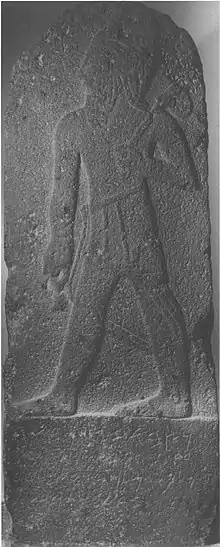Melqart stele
The Melqart stele, also known as the Ben-Hadad or Bir-Hadad stele is an Aramaic stele which was created during the 9th century BCE and was discovered in 1939 in Roman ruins in Bureij Syria (7 km north of Aleppo).[2] The Old Aramaic inscription is known as KAI 201; its five lines reads:
“The stele which Bar-Had-
-ad, son of [...]
king of Aram, erected to his Lord Melqar-
-t, to whom he made a vow and who heard his voi-
-ce.”
| Melqart stele | |
|---|---|
 The stele | |
| Writing | Aramaic inscription |
| Created | 9th century BCE |
| Period/culture | Aramaean |
| Discovered | 1939 |
| Place | Burayj, 7km north of Aleppo, Syria[1] |
| Present location | National Museum of Aleppo |
| Identification | AO 8185 |
According to William Foxwell Albright, the stele should be attributed to Ben-Hadad I, an Aramean king mentioned in the First Book of Kings.[3] However, Kenneth Kitchen disagrees and states that there is no actual evidence that connects the Melqart stele to Ben-Hadad I.[4] a recent re-analysis of the stele indicated that the Ben-Hadad referred to is actually the king of Arpad.[5]
Bibliography
- Maurice Dunand, Stèle araméenne dédiée à Melqart, Bulletin du Musée de Beyrouth III (1939), p. 65–76
- Dunand, Maurice (1942). "A propos de la stèle de Melqart du musée d'Alep". Bulletin du Musée de Beyrouth. 6: 41–45. OCLC 1136089902.
- Albright, W. F. (1942). "A Votive Stele Erected by Ben-Hadad I of Damascus to the God Melcarth". Bulletin of the American Schools of Oriental Research (87): 23–29. doi:10.2307/1355460. JSTOR 1355460. S2CID 163203878.
- Della Vida, G. Levi; Albright, W. F. (1943). "Some Notes on the Stele of Ben-Hadad". Bulletin of the American Schools of Oriental Research (90): 30–34. doi:10.2307/1354906. JSTOR 1354906. S2CID 163726442.
- Jepsen, Alfred (1952). "Zur Melqart-Stele Barhadads". Archiv für Orientforschung. 16: 315–317. JSTOR 41635800.
- Cross, Frank Moore (1972). "The Stele Dedicated to Melcarth by Ben-Hadad of Damascus". Bulletin of the American Schools of Oriental Research (205): 36–42. doi:10.2307/1356214. JSTOR 1356214. S2CID 163497507.
- Black, Matthew. "The Milqart Stele." In Documents from Old Testament Times. Edited by D. W. Thomas, 239-41. London: Thomas Nelson, 1958. Reprinted, Ancient Texts and Translations. Eugene, OR: Wipf & Stock, 2005.
- Dearman, J. Andrew; Miller, J. Maxwell (July 1983). "The Melqart Stele and the Ben Hadads of Damascus: Two Studies". Palestine Exploration Quarterly. 115 (2): 95–101. doi:10.1179/peq.1983.115.2.95.
- Reinhold, Gotthard (1 January 1986). "The Bir-Hadad Stele and the Biblical Kings of Aram". Andrews University Seminary Studies. 24 (2).
Notes
- "Burayj ar Rīḩ, Aleppo Governorate, Syria".
- Pitard, Wayne T. (1988). "The Identity of the Bir-Hadad of the Melqart Stela". Bulletin of the American Schools of Oriental Research (272): 3–21. doi:10.2307/1356783. JSTOR 1356783. S2CID 163606326.
- Albright, W. F. (October 1942). "A Votive Stele Erected by Ben-Hadad I of Damascus to the God Melcarth". Bulletin of the American Schools of Oriental Research. 87 (87): 23–29. doi:10.2307/1355460. JSTOR 1355460. S2CID 163203878.
- Kitchen, K. A. (2006). On the Reliability of the Old Testament. Wm. B. Eerdmans Publishing. ISBN 978-0-8028-0396-2.
- Jo Ann Hackett and Aren M. Wilson-Wright., "A Revised Interpretation of the Melqart Stele (KAI 201)", in SAOC 73. "Like 'Ilu Are You Wise": Studies in Northwest Semitic Languages and Literatures in Honor of Dennis G. Pardee, Studies in Ancient Oriental Civilization 73 Chicago: The Oriental Institute, 2022, pp. 105-112 ISBN 978-1-61491-075-6